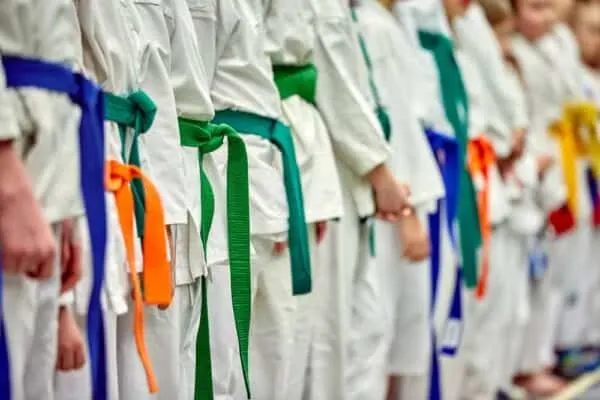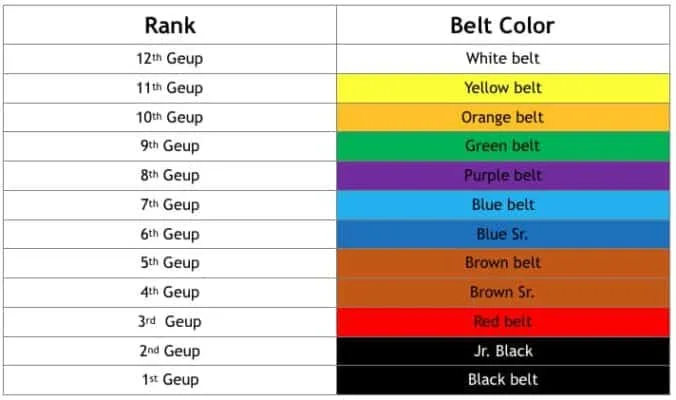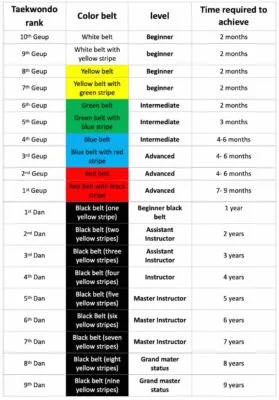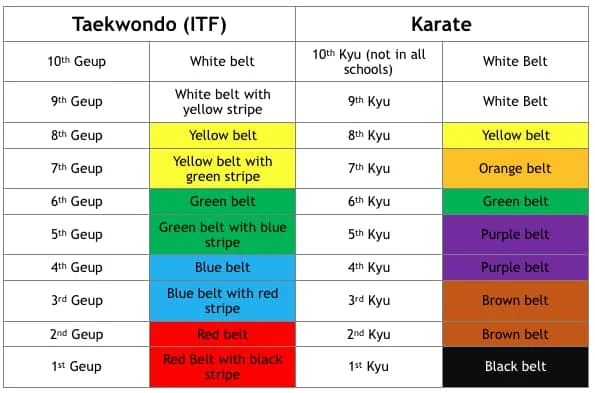
Taekwondo(TKD) is one of the most popular martial arts that is well spread all around the world. Like most other traditional martial arts, Taekwondo training also includes a belt ranking system and strict promotional criteria. But how many color belt ranks are there in Taekwondo?
The number of colored belt ranks varies between the two main styles of Taekwondo, WT and ITF. In ITF, the color belt ranks start from the 10th geup (white belt), all the way down to the 1st dan (black belt). WT belts start from the 12th geup (white belt) to the 1st dan (black belt).
This is just a brief explanation of the Taekwondo belt ranking system. Be sure to read this article to learn more about the color belt ranks, and how this system works.
History of Taekwondo belt ranking system
TKD emerged in the 1950s in South Korea, however, the concept of belt ranking used in TKD has been around for much, much longer. The thing is, Hong Choi and members of other kwans (dojos) that created TKD didn’t invent the color belt ranking system. No, they have actually adopted color belts from Judo, and like most other arts, modified it to suit their system.
The story of the Taekwondo color belt ranking system began in the 20th century in Japan. At the time, Kano Jigoro, a martial art genius who created Judo, was working on developing a unique grading system. His main idea was to create specific ranks that will separate students and competitors by the level of proficiency. The idea of colored belts came after he played the famous Japanese strategic board game called “go” which is similar to chess. The initial colored belt ranking concept had just four belts and many more would follow in the future:
- White
- Blue
- Brown
- Black
The system Kano Jigoro had created was so practical that many other martial arts like Karate, BJJ, and TKD have all adopted this concept. Of course, each of these arts has modified the system according to its needs, but the core of the concept remained the same.
Taekwondo Belt Ranking System Explained
There are two main belt ranking systems in Taekwondo: WT and ITF, and you are going to learn all about both in this article. The most important thing to remember is that the ranking system in both styles is separated into two groups:
- Junior group (color belts “geups”) — includes between 10 (ITF) and 12 (WT) color belts and each rank is called “geup”. The beginners always start by wearing a white belt, and they have to go through eight more color belt ranks before reaching the final, black belt rank.
- Senior group (black belts “Dan”) — is made up of nine different black belt ranks and each rank is called “dan”, which is a Korean word for a “degree”. Students start the “dan” rank when they complete all the ranks in the junior group.
TKD Senior (Dan) belt levels are the same in WT and ITF styles of Taekwondo but junior belt ranking systems are different. Here is a list of all the junior(geups) color ranks.
International Taekwondo Federation (ITF) junior belt ranks:

World Taekwondo (WT) belt ranks:

LEARN MORE Check out our article on Karate Belt Ranking System – EASILY Explained For Beginners
How Do You Progress in Taekwondo?
To achieve a higher rank, all TKD students need to pass a specified belt test, and the promotional testing is organized every two, three or four months depending on the school. Tests usually include a panel of judges and coaches in front of which students need to perform. Each student must demonstrate a high level of technical and tactical proficiency required for the rank they want to achieve. Tests are usually not hard to pass in the lower ranks, but get tougher with each higher rank. In most schools, students are required to perform:
- Patterns/forms (Poomsae) which include different blocks, punching and kicking combos. Each student is performing alone and they must execute all of the techniques in perfect motion and without mistakes.
- Sparring against other students to demonstrate a practical application of the techniques in a real fight
- Breaking boards to display power and control
- Perform physical exercises to demonstrate the required fitness level
- Theoretical test where students need to answer questions about terminology, different concepts, and the history of Taekwondo.
- In senior (dan) ranks, students need to pass a written test before they can move to the practical test.
In some schools, students also need to show consistency and loyalty to get promoted to the next belt. They must show up to the dojo at least 3 times a week, and even attend special training classes to prepare for a test. They must also show loyalty to the school by attending promotional events, and following all the rules and regulations.
How much time it takes to move from one rank to the next truly depends on the level you are at. Students in the lower ranks tend to progress much faster because tests are not that complex. They usually need to show an improved level of fitness and perform between 8 and 9 offensive and defensive forms. But, tests get more difficult and progress slows down when they reach intermediate and advanced ranks.
Next, bear in mind that the criteria and time that you need to move from one rank to the next one depends on the school. Promotional tests in some schools are not that difficult and you can climb through the ranks much faster. However, reaching a black belt in a short time span comes at a certain price as you won’t be as proficient as students who train in traditional dojos where promotional criteria are strict.
How Long Does it Take to Get Each Belt in Taekwondo?
Here is a detailed look at how long it takes to get each color belt in taekwondo. However, the following guidelines are for those who are committed to training at least 3 times a week.

How Long Does It Take to Get a Black Belt in Taekwondo?
On average, it takes between 3 and 5 years for a student with average talent and fitness level to reach a black belt rank (1st Dan) in Taekwondo. As in other sports, the exact time depends on many factors like your talent, fitness level, dedication, and passion. But bear in mind that is almost impossible to achieve a black belt rank in less than 3 years due to the strict promotion criteria.
However, there are schools where promotional criteria are not at the highest levels. In fact, it might be very low and these schools allow their students to progress through the ranks fast, and reach a black belt in less than 3 years. In fact, some schools go even further by guaranteeing that you are going to reach a black belt rank in 2 years for example. You should avoid this type of low-quality martial arts school.
Owning a black belt is great but it’s useless in this case simply because you won’t be skilled enough to be a TKD black belt. Or in other words, a legitimate blue belt who trains in a traditional dojo with the highest standards of promotion might be far more skilled than someone who got their black belt in 2 years. Also, students who got their black belts in a short time usually do not perform well in the competition. Therefore, if you want to be good at TKD, it’s in your best interest to avoid any school that offers you a fast track program to black belt .
LEARN MORE Get the full report on Is Taekwondo Worth Learning? Here’s What You Need to Know
What is the Highest Degree of TKD Black Belt You Can Earn?
The highest degree/rank in Taekwondo is the 9th Dan Black Belt that is also known as “Grand Master” rank. This is also the highest rank that is awarded to the living people as the “10th dan black belt” is usually awarded posthumously. The only exception made was when Kim Ki-Wang received a 10th dan rank while lying in the hospital bed shortly before he died of cancer in 1993.
In WT, there have been 6 “10th Dan” black belts and 45 “9th Dan” black belts, while ITF has 39 “9th Dan” black belts and not a single person owns and 10th dan. The people with the highest 10th dan rank in WT are:
- Choi Joon
- Lee Moo-yong
- Kim Ki-whang
- Lee Jong-soo (aka: Chong Lee)
- Sell Edward B
- Pan Sim-woon
TKD Belts vs Karate Belts – Difference and Comparison
The belt ranking systems in Taekwondo (ITF) and most styles of karate are very similar because the concept is the same. Both of these arts have adopted a color belt rank from Judo created by Kano Jigoro. And, both TKD and karate include two separate belt ranks for junior and senior students with the number of ranks being the same.
For example, TKD includes 10 different color belt ranks called “geup’ for junior students, and additional 10 “Dan” ranks for senior students. Karate on the other hand also has 10 junior ranks called “Kyu”, and the same number of Dan ranks, 10. The main differences are the belt colors and the time you need to spend training to move from one belt to the next one. Here is a detailed comparison:

LEARN MORE Check out our article on Karate vs. Taekwondo: Key Differences And Similarities
Related Questions
What MMA fighters are TKD black belts?
Throughout MMA history, there have been many Taekwondo black belts who enjoyed a lot of success competing at the highest levels of modern MMA. The following is a list of some of the most famous ones:
- Rose Namajunas — is the UFC strawweight champion and one of the most famous UFC fighters. She started training Taekwondo at the age of 5 and had reached a black belt rank just four years later. Inside the octagon, she shines with various TKD kicks like axe and front kicks.
- Yair Rodriguez — is a UFC fighter who is probably the best example of TKD in modern MMA. He is one of those awkward fighters who does not hesitate to throw flashy jumping and spinning kicks.
- Anderson Silva — is one of the greatest UFC fighters of all time who has a strong background in TKD where he is a 5th Dan black belt. This makes him one of the highest-ranking TKD practitioners in MMA.
- Valentina Shevchenko — is the UFC champion and a master in many martial arts, including Taekwondo where she owns a 2nd Dan black belt rank.
- Anthony Pettis — is the former UFC lightweight champion who has been training in Taekwondo since the age of 5. By the age of 18, Pettis was already a 3rd Dan black belt.
Who is the father of Taekwondo?
South Korean Army general Choi Hong-hi is widely regarded as the father of Taekwondo. Choi played a big role in the development of TKD back in the 1940s and 1950s, but bear in mind that he didn’t create TKD alone. He was the founder of the first “International Taekwondo Federation” and its first president. Although Choi didn’t develop TKD alone, he is directly responsible for regulating TKD and making it popular all across the world.
LEARN MORE Check out our article on Bruce Lee – Why He Is Considered The Father Of MMA
